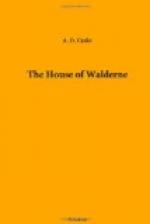This magnificent abbey had been endowed by Robert D’Oyley, nephew of the Norman Conqueror, mentioned in another of our Chronicles {12}. It was situated on an island, formed by various branches of the Isis, in the western suburbs of the city, and extended as far as from the present Oseney Mill to St. Thomas’ Church. The abbey church, long since destroyed, was lofty and magnificent, containing twenty-four altars, a central tower of great height, and a western tower. Here King Henry III passed a Christmas with “reverent mirth.”
There was a large gathering of monks, friars, and students; the quiet sober side of Oxford predominated in the early dawn, and Martin thought he had never seen so orderly a city. He was destined to change his ideas, or at least modify them, before he laid his head on his pillow that night.
Before leaving the church Martin ascended to the summit of the abbey tower, the wicket gate of which stood invitingly open, in order to survey the city and country, and gain a general idea of his future home. Below him, in the sweet freshness of the early morn, the branches of the Isis surrounded the abbey precincts, the river being well guarded by stone work and terraces, so that it could not at flood time encroach upon the abbey. Neither before the days of locks could or did such floods occur as we have now, the water got away more readily, and the students could not sail upon “Port Meadow” as upon a lake, in the winter and spring, as they do at the present day.
Beyond the abbey rose the church and college of “Saint George in the Castle,” that is within the precincts of the fortress, and the great mound thrown up by Queen Ethelflaed, a sister of Alfred, now called the Jew’s Mount {13}, and the two towers of the Norman Castle seemed to make one group with church and college. The town church of Saint Martin rose from a thickly-built group of houses, at a spot called Quatre Voies, where the principal streets crossed, which name we corrupt into Carfax. He counted the towers of thirteen churches, including the historic shrine of Saint Frideswide, which afterwards developed into the College of Christchurch, and later still furnished the Cathedral of the diocese.
Around lay a wild land of heath and forest, with cultivated fields very infrequently interspersed; the moors of Cowley, the woods of Shotover and Bagley; and farther still, the forests of Nuneham, inhabited even then by the Harcourts, who still hold the ancestral demesne. Descending, he made his way to Greyfriars, as the Franciscan house was called, encountering many groups who were already wending their way to lecture room, or, like Martin, returning to break their fast after morning chapel, which then meant early mass at one of the many churches, for only in three or four instances had corporate bodies chapels of their own.
These groups were very unlike modern undergraduates; as a rule they were much younger people, of the same ages as the upper forms in our public schools, from fourteen or fifteen years upwards; mere boys, living in crowded hostels, fighting and quarrelling with all the sweet “abandon” of early youth, sometimes begging masterfully, for licenses to beg were granted to poor students, living, it might be, in the greatest poverty, but still devoted to learning.




